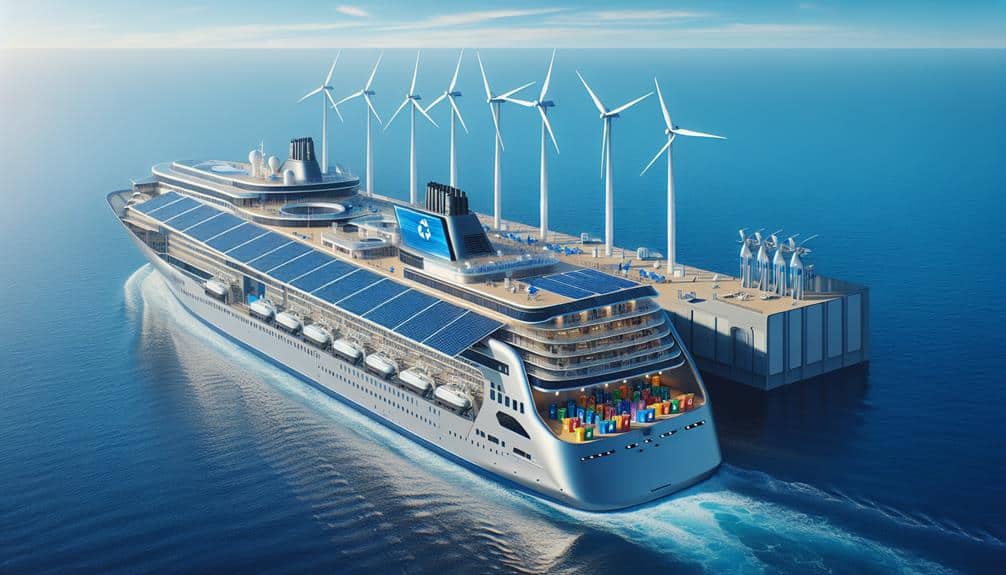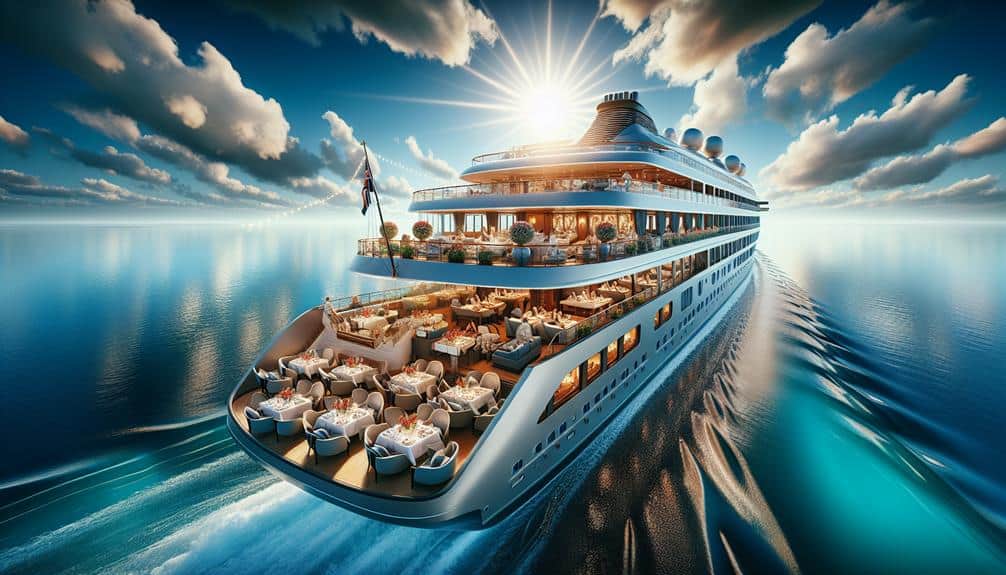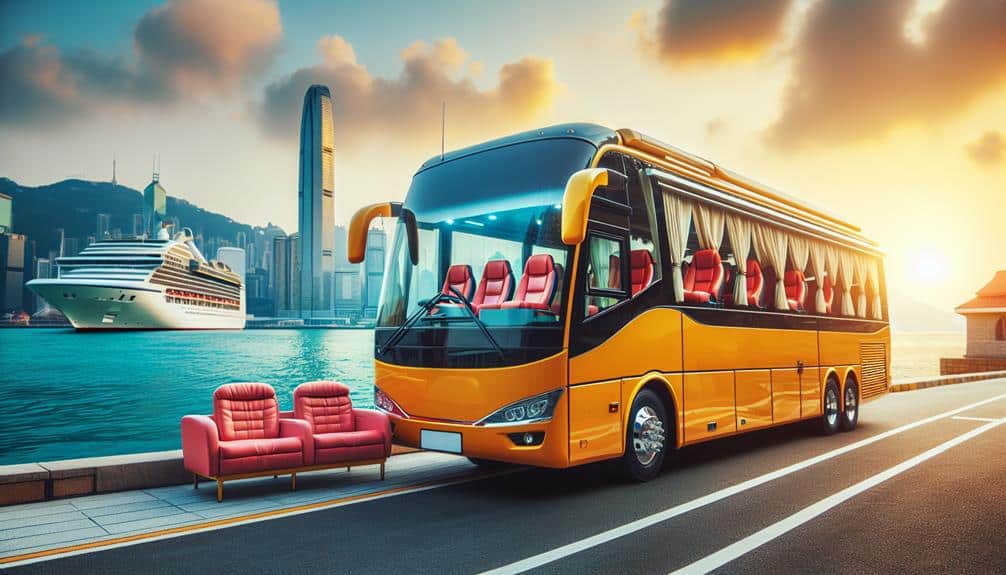Explore the cutting-edge sustainable innovations reshaping maritime travel. Hybrid propulsion systems optimize fuel consumption, significantly improving efficiency and reducing costs. Solar panel integration boosts energy efficiency, lowering carbon footprints. Energy-efficient hull designs with sustainable materials and advanced composites enhance fuel efficiency. Waste-to-energy tech converts solid waste into renewable sources, reducing reliance on fossil fuels. Shore power connections reduce emissions while docked, drawing electricity from renewables. These innovations revolutionize traditional cruise ship transportation, offering game-changing solutions for a greener, more sustainable industry.
Key Points
- Hybrid propulsion systems optimize fuel consumption and reduce environmental impact.
- Solar panel integration boosts energy efficiency and decreases reliance on traditional fuels.
- Energy-efficient hull design reduces fuel consumption and improves sustainability.
- Waste-to-energy technology converts waste into renewable energy, reducing fossil fuel reliance.
- Shore power connection reduces emissions, minimizes air pollution, and promotes greener maritime practices.
Hybrid Propulsion Systems
Hybrid propulsion systems offer a sustainable solution for powering modern cruise ships, combining traditional fuel sources with innovative technologies to reduce emissions and enhance efficiency. By integrating electric propulsion with conventional engines, these systems optimize fuel consumption and minimize environmental impact. Fuel efficiency is notably improved as the electric component can power the ship at lower speeds or during specific maneuvers, reducing the overall consumption of fossil fuels. This approach not only cuts down on operational costs but also plays an essential role in emissions reduction.
Through clever engineering and sophisticated control systems, hybrid propulsion enables cruise ships to achieve a more balanced power distribution, utilizing the most efficient source based on the vessel's speed and load requirements. This dynamic management leads to a substantial decrease in greenhouse gas emissions and pollutants released into the atmosphere, aligning with the industry's push towards greater sustainability. By prioritizing fuel efficiency and emissions reduction, hybrid propulsion systems represent a pivotal advancement in the evolution of eco-friendly maritime transportation.
Solar Panel Integration
Integrating solar panels into cruise ship design presents a promising avenue for boosting energy efficiency and reducing environmental impact in maritime transportation. Renewable energy sources like solar power offer a sustainable solution to meet the energy demands of cruise ships while minimizing their carbon footprint. Solar panel integration allows cruise ships to harness the power of the sun to generate electricity, reducing reliance on traditional fuel sources and decreasing greenhouse gas emissions.
Energy-Efficient Hull Design
An energy-efficient hull design on a cruise ship plays an important role in reducing fuel consumption and enhancing overall sustainability in maritime operations. Hull efficiency is a critical aspect of eco-friendly cruise ship transportation innovations. By incorporating sustainable materials like high-performance coatings and advanced composite materials, cruise ships can greatly improve their hydrodynamics, reduce drag, and enhance fuel efficiency. These materials help in minimizing frictional resistance as the ship moves through water, ultimately leading to lower fuel consumption and fewer emissions.
Innovations in hull design, such as bulbous bows and streamlined hull shapes, further contribute to enhancing the overall energy efficiency of cruise ships. These design features help in reducing wave-making resistance and improving the flow of water around the hull, resulting in optimized performance and reduced energy expenditure. By prioritizing energy-efficient hull design and utilizing sustainable materials, cruise ship operators can make significant strides towards achieving environmental sustainability in their operations while simultaneously reducing operating costs.
Waste-to-Energy Technology
Improving waste management practices onboard cruise ships can greatly enhance sustainability efforts by implementing Waste-to-Energy technology. This innovative approach involves converting solid waste generated on the ship into renewable energy sources. Through advanced processes like incineration, organic waste can be turned into heat and electricity, reducing the need for traditional fossil fuels and decreasing the environmental impact of cruising.
Waste-to-Energy technology not only addresses the issue of waste management but also contributes to the cruise industry's shift towards more sustainable operations. By utilizing the energy potential of waste materials, cruise ships can reduce their carbon footprint and reliance on non-renewable resources. This advancement aligns with the industry's commitment to environmental stewardship and offers a practical solution to the challenges of waste disposal at sea.
Incorporating Waste-to-Energy technology into cruise ship operations represents a significant step forward in enhancing sustainability practices within the maritime sector. By harnessing the power of waste, cruise lines can move closer towards achieving their environmental goals while also promoting a circular economy mindset that maximizes resource efficiency.
Shore Power Connection
The utilization of shore power connection on cruise ships greatly reduces emissions while docked at port. By enabling ships to plug into the local electrical grid instead of running their engines, shore power connection helps minimize air pollution and greenhouse gas emissions. This innovation is a key step towards creating a more sustainable cruise industry.
Shore power connection allows cruise ships to draw electricity from renewable energy sources, such as wind or solar power, further reducing their environmental impact. This shift towards cleaner energy sources contributes to decreasing reliance on fossil fuels and mitigating the carbon footprint of cruise travel.
Implementing shore power connection infrastructure at ports worldwide is essential for maximizing the environmental benefits of this technology. Coordinating efforts between cruise lines, port authorities, and energy providers can guarantee that ships have access to renewable energy sources while in port, making significant strides towards a greener maritime industry. By embracing shore power connection, cruise ships can operate more sustainably and reduce their overall impact on the environment.
Frequently Asked Questions
How Do Cruise Ships With Hybrid Propulsion Systems Switch Between Different Power Sources While at Sea?
When at sea, cruise ships with hybrid propulsion systems smoothly shift between power sources to optimize efficiency. This intricate process guarantees minimal environmental impact and maximizes energy utilization, showcasing cutting-edge technology in maritime transportation.
Are There Any Safety Concerns or Risks Associated With Integrating Solar Panels Onto Cruise Ships?
You might worry about safety concerns, but integrating solar panels on cruise ships is a smart move. They reduce emissions and fuel costs, contributing to a cleaner environment. Proper installation and upkeep guarantee minimal risks.
How Does Energy-Efficient Hull Design Contribute to Reducing a Cruise Ship's Carbon Footprint?
Energy-efficient hull design utilizes advanced materials to reduce drag, enhancing sustainability. This innovation greatly lowers fuel consumption, consequently decreasing carbon emissions and lessening the environmental impact of cruise ships. Embrace these solutions for a greener voyage.
What Happens to the Waste That Is Converted Into Energy Using Waste-To-Energy Technology on Cruise Ships?
When waste is converted into energy through the waste-to-energy process on cruise ships, the environmental impact is significant. It reduces landfill waste, minimizes greenhouse gas emissions, and provides a sustainable energy source, contributing to a cleaner ecosystem.
How Does Shore Power Connection Work and How Does It Benefit the Environment Compared to Traditional Power Sources While Docked?
When you connect to shore power, your cruise ship uses electricity from the land instead of burning fuel onboard. This reduces energy consumption and environmental impact, promoting sustainability by tapping into cleaner electricity sources while docked.



